
The Ultimate Guide To Remarkable Content
By reading this Ultimate Guide you’re already taking the first steps on your journey to a Rich Life. This is only an introduction to the ideas and material you’ll find inside IWT. I started this site in 2004 while I was studying technology and psychology at Stanford. I’ve spent the time since testing and honing my Rich Life systems on thousands of successful students.
At IWT you’ll learn –
Buy all the lattes you want. A $5 coffee is not going to change your financial life. But learning how to automatically invest, how to select the right asset allocation, and how to negotiate a $15,000 raise will. I believe in asking $30,000 questions, not $3 questions.
Your Rich Life is yours. A Rich Life can be picking up your kids every day from school. Or buying a $1,000 cashmere sweater. It can be buying a round of drinks for your friends, or traveling for 8 weeks per year. You decide. Your Rich Life is yours. (Here are some of my Money Rules.)
There’s a limit to how much you can cut, but no limit to how much you can earn. I have readers who earn $50,000/year and ones who earn $750,000/year. We’ve helped tens of thousands of people earn more money by negotiating their salaries, investing, and starting businesses.
Spend extravagantly on the things you love, as long as you cut costs mercilessly on the things you don’t. I don’t believe in cutting back on lattes. In fact, I want you to spend more on the things you love. What if you could double your spending on travel, or eating out, convenience, or charity? I call those Money Dials and I’ll show you how.
The 85% Solution: Getting started is more important than becoming an expert. You don’t need to be perfect to take control of your money. It’s OK to make mistakes. Get 85% of the way there and move on with your life.
Investing should be very boring—and very profitable—over the long term. I get more excited eating tacos than checking my investment returns. You’re in control. This isn’t a Disney movie and nobody’s coming to rescue you. Fortunately, you can take control of your finances and build your Rich Life.
Money is political. You can simultaneously acknowledge personal responsibility and real systemic problems. This is a core part of the I Will Teach You To Be Rich philosophy. Housing is political. Healthcare is political. Voting rights are political. If you’re looking for bland tips on cutting coupons, this site is not for you. I consider it a tragedy to live a smaller life than you have to. So many of us have been raised to believe that money is something to be scared of. We use phrases like “I’m not good with money” or “Money changes people.” Yes, money does change people.
Money allowed me to dream bigger, to be more generous, and to be more adventurous. It can do the same for you. A Rich Life is lived outside the spreadsheet. What’s the point of all this saving and investing if you’re simply going to wait until you’re 80 to live? No thanks. I believe that once you’ve set up your finances, you’ll see that the most important part of a Rich Life is outside the spreadsheet—it involves relationships, new experiences, and giving back. You earned it. Welcome to your Rich Life journey, I’m excited to see what you do next.
* Watch founder Ramit Sethi on Netflix
* Get the NYT-Bestselling book
* Check out the hit podcast
And join over 800,000 readers getting our Rich Life Insiders newsletter:
How to Create Remarkable Blog Posts That Make You an Instant Expert, Attract Hundreds of Comments and Shares, and Flood Your Site with Traffic
You know it when you see it.
From the opening words to the very last sentence, you can’t stop reading it. It effortlessly pulls you down the page. It intrigues you. It tells a great story. It makes you feel good.
When you’ve devoured the final word, you bookmark it and share it with your friends. Turns out, you’re not the only one who loved it either. At the bottom of the post, you see hundreds of comments. Thousands of social shares.
All from people praising the writer. All from readers begging for more.
Welcome to the world of remarkable content.
You’ve seen awesome writing like this, right? Work that creates reputations and builds businesses.
Maybe you read people like Tim Ferriss, Neil Patel, Brian Clark, or one of the other bigname bloggers who regularly produce high-caliber material you can’t get enough of.
Their amazing content turned them into respected experts, helped them build a loyal fan base, and opened up huge opportunities in their business and personal lives. And it all started with great content.
Great content that they produce every day
The real question is: Can you do the same?
Can you get hundreds of people to reply to your emails? Can you attract thousands – even tens of thousands – of new subscribers every time you hit “Publish?”
Yes, you can.
Even if you don’t have a fancy English degree.
Even if you don’t have years of writing experience.
And even if you’re pressed for time.
There is a proven system for creating remarkable content. A system that helps you churn out amazing articles, blog posts, and emails – anytime you want.
And it’s exactly what I have for you in this Ultimate Guide.
Here’s How I Know This Works:
A few years ago, I Will Teach You To Be Rich was just a tiny blog nobody read. Want proof? Just dig into some of my earliest posts. I went months and months without a single comment. But through the years, I kept writing.
I kept improving my craft. And, most importantly, I figured out what people actually wanted to read. Over time, I got more eyes on the page, more comments, and more shares.
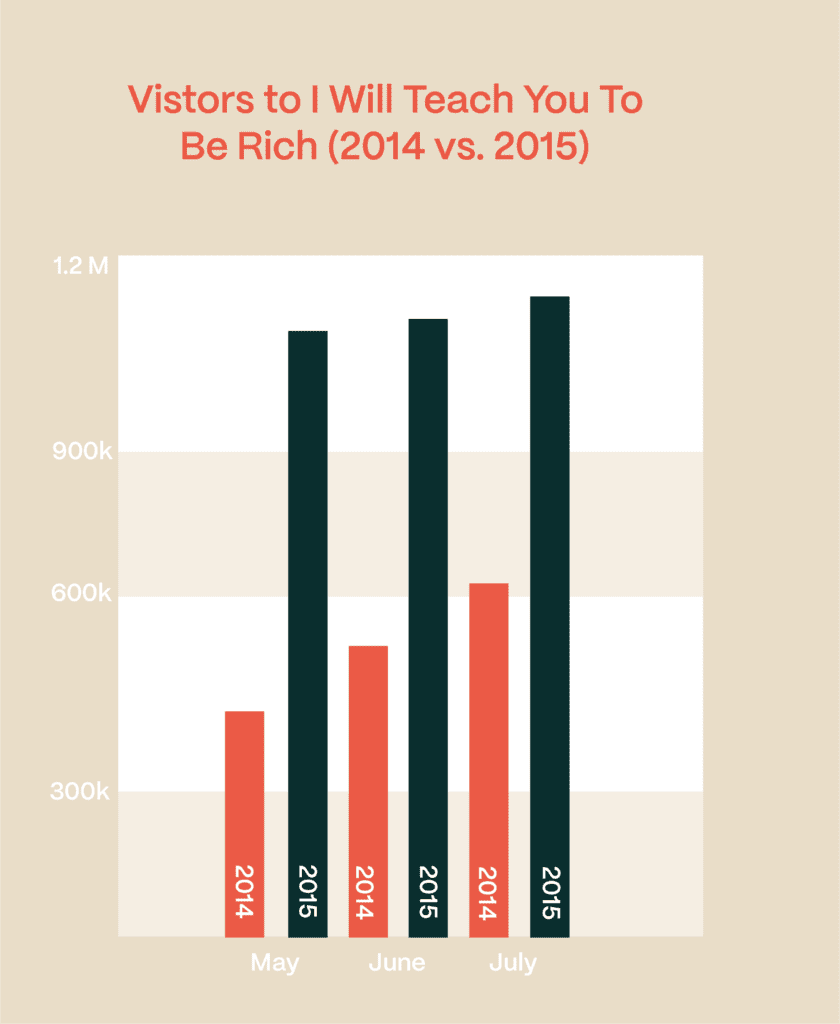
Today, millions of people visit my blog every month. Yep, that dinky, little blog – that nobody read – turned into a site with more than 1,000,000 readers every 30 days.
Was it because of some amazing SEO tactic I used? Or some secret strategy I whipped out to create quick traffic surges? No. Actually, that stuff doesn’t matter as much as you’d think.
The secret isn’t WHAT I was writing about – I write about everything from psychology to social skills to salary negotiation to personal finance.
The secret was HOW I was writing about it. And once I cracked the code, my blog took off.
Will Your First Post Get a Million Readers Overnight?
Let’s be realistic: Probably not. But can you get hundreds or even thousands of readers and build from there? Absolutely.
Because I’m going to reveal some of the best strategies I’ve learned over the past decade of blogging.
No more “figuring it out” on your own – eventually. No more wasting time writing something people don’t want to read. Remarkable content can make you an instant expert, attract thousands of fans, and multiply your business.
A Quick Snapshot of Some of the Experts You’ll Learn From:
Neil Patel
Co-founder of Crazy Egg, Hello Bar, and KISSmetrics. Neil was named one of the top 10 online marketers by Forbes and writes about online marketing at QuickSprout.com.
Mark Manson
Author, blogger, and entrepreneur. He writes about unconventional living and personal development at his blog, MarkManson.net.
Brian Dean
An internationally-recognized entrepreneur and SEO expert. He is the founder of Backlinko.com, which provides practical strategies that professionals can use to get more search engine traffic.
John Romaniello
Angel investor, author, and expert in the fields of fitness, writing, and marketing. John is the author of the New York Times best-selling book, “Man 2.0 Engineering the Alpha,” and blogs at JohnRomaniello.com.
Steve Kamb
Author and the creator of NerdFitness.com, a website to give average people struggling to get healthy a fighting chance.
In This Guide, You’ll Learn:
The anatomy of a viral blog post
Did you know there’s a science to creating unforgettable content? That’s right. If you have all the right ingredients, all you have to do is put them together to create amazing content every time. In Part 1, I’ll show you the exact ingredients you need to get started, and introduce you to popular bloggers who’ve leveraged their viral blog posts and changed their lives.
From blank page to compelling post
Do you hate staring at a blank page? Want to know the simple triggers I use so that I never get stuck with nothing to say? In Part 2, I’ll teach you the 4 simple strategies I use to create compelling content every time I face the page – it’s easier than you think.
How to polish your work to perfection (even if you aren’t a great writer)
Have you ever wondered how some writers churn out awesome stuff day after day? You can do it, too. In Part 3, I’ll show you some of my best strategies and tips for creating awesome content every time. (My favorite tip? The “bar test.”)
Unlocking your creativity & finding time to write
What’s the hardest part about writing? According to the thousands of people I’ve surveyed – it’s being creative on demand and stealing time from an already packed schedule to create content. In Part 4, I’ll show you how to crack the code on your creativity and find all the time you need to write remarkable content.
Lessons from the masters
What do top bloggers know that the rest of us don’t? I surveyed them to find out. In Part 5, I’ll share their best insights and secrets for building a huge audience and lots of raving fans.
How to get published on top blogs (and get A LOT of people to read it)
Want to know the secret to building your audience? Getting published on HUGE sites. In Part 6, I’ll show you how one of my students got published on a site that has a massive readership and made more than $30,000 with just one guest post. I’ll also hand you the exact scripts you need to replicate her success.
You’re missing the full experience! The original, unabridged version of this guide is available to download as a PDF. It’s 100% free – just tell us where to send it.
Part 1: The Anatomy of a Viral Blog Post
You only need one amazing blog post to get the attention of VIPs and top bloggers in your industry.
It’s true. With one piece of remarkable content, you can instantly turn yourself into a sought-after expert. The catch? You’ve got to create that amazing post first. Let me show you how that’s done. To do that, I’m going to break down exactly what you need to write a viral blog post.
Everything You Need to Create a Viral Blog Post
No two pieces of remarkable content are the same. But there are a few key components that every extremely successful piece of writing must have.
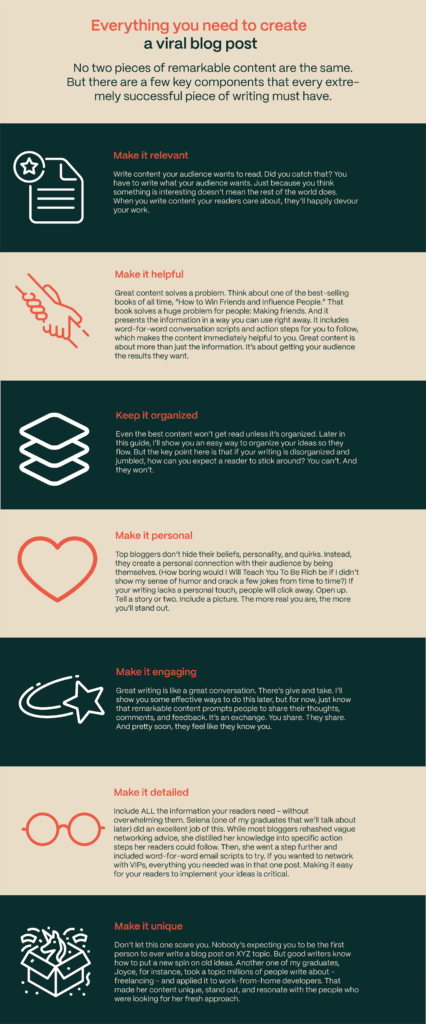
Now that you know what it takes to write viral content, I want you to get a peek behind the scenes at the results some of my graduates have gotten from creating it.
Results in Action
Here are just a few of my graduates who created viral content using the strategies in this Ultimate Guide. Using the system I teach, they’ve attracted tons of new readers and have been featured on popular sites, blogs, and podcasts.
Meet Joyce Akiko, the self-taught coder who got over 25,000 views on Lifehacker.
Joyce spent years learning how to be a freelance programmer. One day, she decided to share what she’d learned along the way in this single, detailed blog post. Because she spent time – upfront – making the content truly remarkable, her post resonated with tens of thousands of people. In fact it was so good, one of the writers at Lifehacker decided to feature her work. That one feature alone got more than 25,000 views and brought hundreds of new subscribers to her list.
Meet Selena Soo, the publicity coach who made $30,000 from one guest post.
Another one of my graduates, Selena, created one viral guest post. Because of how personal and detailed the post was, it received 250 comments, over 1000 shares, and she attracted over 2000 new subscribers to her mailing list.
The end result: She earned more than $30,000 from that ONE guest post.
In the video below, she talks about how this one post changed everything for her business.
Part 2: From Blank Page to Compelling Post
The first time I sat down to write a blog post, I thought, “I talk all the time. And I never run out of things to say. Why can’t I just get this stuff down on paper?”
Writer’s block – that’s why.
Everybody hates staring at a blank page. So I’m going to show you how to do away with them for good. It’s all in the preparation. If you change the way you prepare, writer’s block will be a thing of the past.
Below are 4 simple strategies I use to create compelling content every time I face the page.
#1 – Write About What You Know
There’s a reason I don’t write about learning foreign languages or computer coding. I don’t know how to do any of that stuff! If I tried to write about it, it would be really hard to get started.
But since I write about topics I’m interested in – like psychology, money, or business – it’s 10x easier for me to find the right words. I care about those things, and, more importantly, I WANT to write about them.
Being interested in what you’re talking about and knowing about the topic plays a huge part in defeating writer’s block. And, you don’t have to be an expert to get started. You just have to know enough to write about one thing. After you write about that one thing, you can learn about something else. Then write about that.
That’s what great bloggers do.
Eventually writing becomes fun and the ideas start flowing. And, you’re no longer staring at a blank page.
#2 – Gather Your Research
Do you know the number one reason people get writer’s block? They haven’t done enough research. They’re just hoping to crank out pages of material – without doing any work up front. That’s a bad strategy, and it sets you up to fail. The better way is to find the information you need – BEFORE sitting down to write. If you do that, it’s easy to produce pages of great work.
Simple ways to do lots of research without spending lots of time:
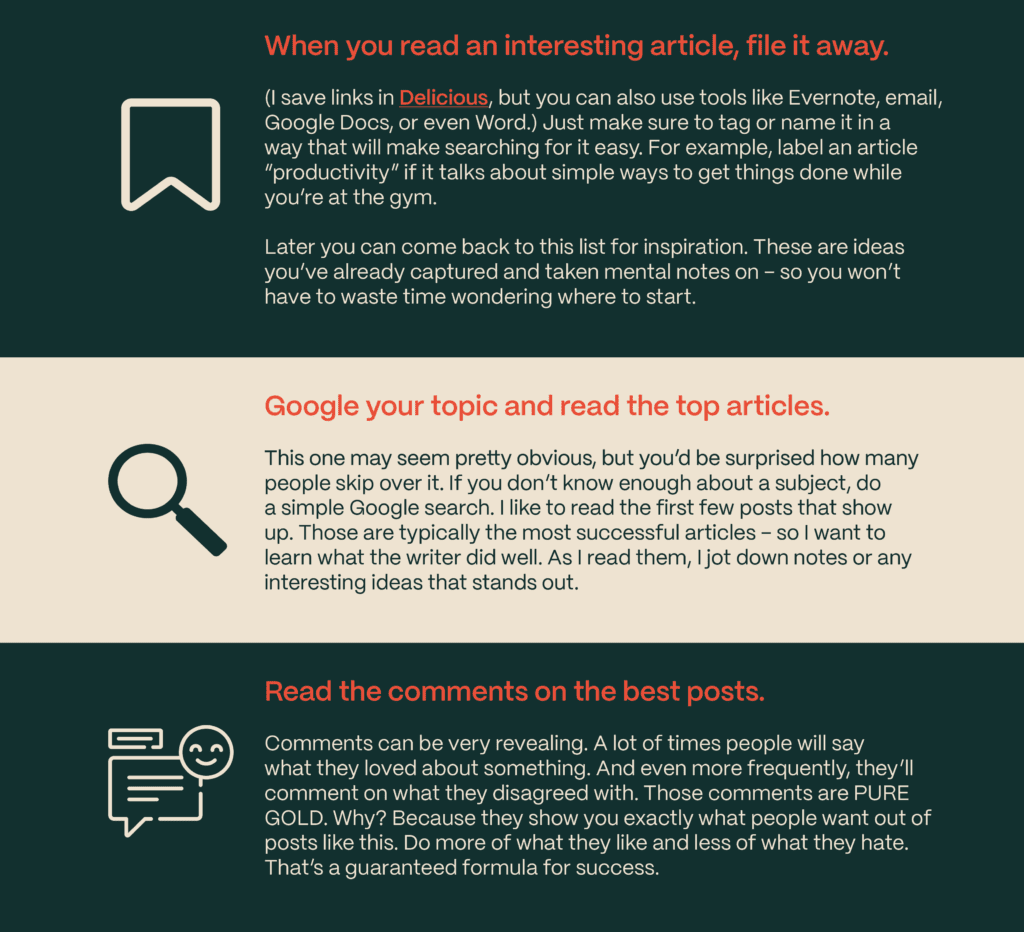
#3 – Outline Now – So You Can Save Time Later
When I finished my last English class in college, I told myself, “Thank god, I’ll never write another outline again.”
But boy, was I wrong.
Over the last few years, I’ve written thousands of outlines. I use them for everything from emails to blog posts to sales pages. I’m not kidding when I say I use outlines for everything. I won’t even jot down a few paragraphs without putting together a quick outline first. I started doing this because ALL of my favorite writers said outlines were one of the secrets to their success. And 99.99 times out of 100, if everyone is telling you to do something, they’re probably right.
Outlining works because it helps you accomplish three things:
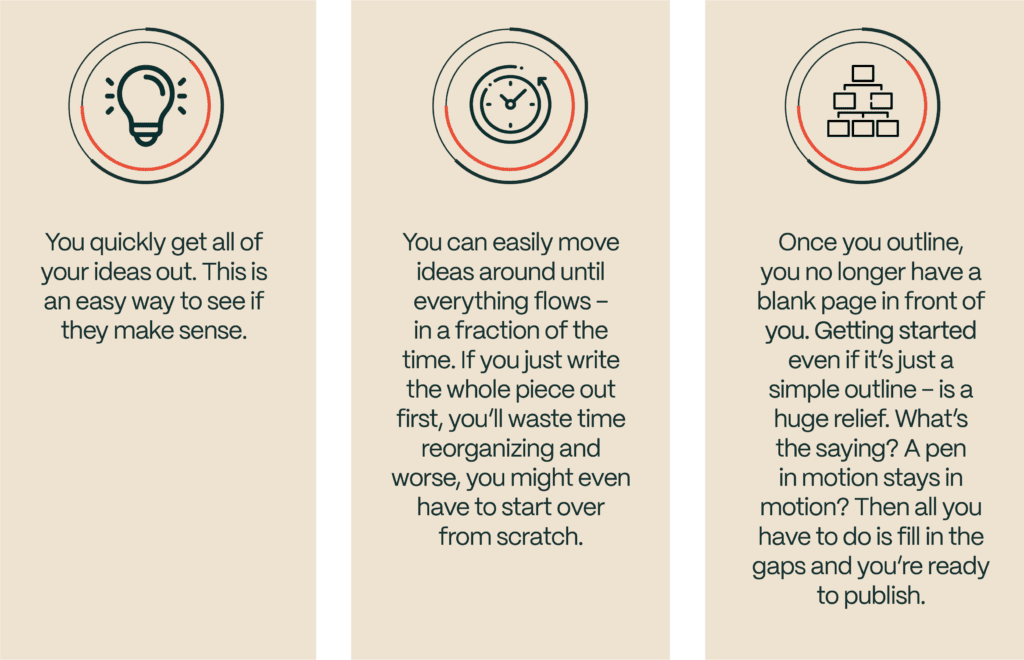
If you’re curious about what my outlines include, here’s a quick peek at a typical blog post:
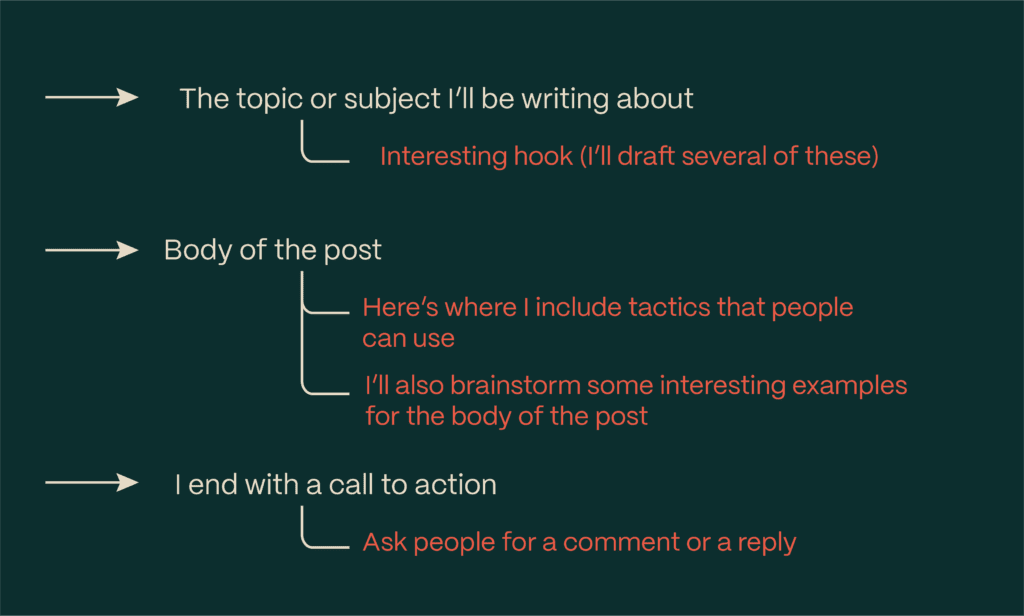
Notice how simple this is. It makes it easier to get started. Your outline can be as brief or detailed as you want. You’re not doing it for other people. You’re just giving yourself a framework to start writing. And once you have the skeleton, you can turn it into great content in a fraction of the time.
#4 – Flesh Out Your Outline
Okay. You’ve done the research.
You have an outline. You know exactly what to write and in what order you should do it.
Next up? Start writing.
It doesn’t have to be perfect – and it won’t be. Just give yourself permission to write a “shitty first draft.” (I’ll show you how to polish it next.)
Real Teardown
It’s one thing to TELL you how to write compelling content, but one of the best ways to actually be able to write content like this for yourself is to SEE the differences between copy that’s good and copy that’s truly great.
That’s why I wanted to go one step further and show you this difference. When you nail this down and know how to make good copy great, you won’t just get a few hundred more likes or a few dozen more followers.
No. Great content leads to dramatically different results. You can build a business around great content. But content that’s just okay…it falls on deaf ears.
So to show you this, I wanted to compare the copy that my friend, John Romaniello, writes on his site, Roman Fitness Systems. His content is truly remarkable.
And we’ll be comparing what he writes to another fitness writer. I purposely chose content that is already pretty good. But with a few tweaks, it could be truly excellent.
The first thing that we’ll be looking at is the hook. If you can’t get the reader past the first few lines, then you won’t get them to the meat of the post or, more importantly, to your offer at the bottom of the page. Let’s take a look at the difference in John’s hook vs that of the other fitness writer.
John's Hook:
“Okay. Okay. Okay. OKAY. Look. I’m going to admit right off the bat that I’m making a bad decision. Something I shouldn’t do. Something I always tell other people NOT to do: I’m writing this email in the midst of what you could call a heightened emotional state.
I’m not exactly pissed off, and neither am I perversely sad. But I’m definitely annoyed. And being annoyed gets my writing gears going, and makes me want to rant. In the interest of not being a total dick, I will do my best to keep this from becoming a rant, but I make no promises. Cool? Cool.
So. Here’s the thing. I hate flakiness. I really can’t stand it. It’s one of the worst qualities in the world–for me, flaky people fall somewhere between people who don’t like dogs, and those annoying couples who make JOINT social media profiles. WHAT THE HELL IS WRONG WITH YOU?
*sigh* (don’t rant don’t rant don’t rant.)”
Shabofit's Hook:
“Let’s be real. You found your way here because you have an interest in becoming healthier, stronger, and sexier. Respect. Everyone deserves to be healthy, strong, and sexy.
It makes the world a better place.
But with a stressful and busy life, you don’t know where to start.
Most are looking for the magic solution – a crash diet, fad workout, or false promise.”
Key Differences in Email Hooks
Right off the bat, you can tell that John’s hook is super engaging. He’s talking to you just like a friend would. You don’t feel like you’re being sold. You just feel like you’re being entertained, kicking back with a friend to hear a good story.
The other writer doesn’t do a terrible job of using short sentences and writing in a way that’s laid back. But notice that you already feel like you’re about to be sold something. Also notice that – while all the right buzzwords are crammed into this intro – there’s no emotional connection.
John is talking about being upset. John is using words like “total dick.” But it works because John is being a real person.
Today, we’re all bombarded by content – from hundreds of different angles – the person who talks like a real person wins. Because nobody wants to be sold something. We want to be entertained and talk with our friends.
Now, I’ve only skimmed the surface of the differences between those two intros. But read them one more time for yourself and ask, “How can I make my content more real?” “How can I avoid saying buzzwords for buzzwords’ sake?“ “How can I talk like I would to my friends?” “How can I craft a narrative in my content – so that I’m not always just selling something or telling people what to do?”
John's ask for more coaching clients:
“It’s really awesome how much the program has grown and changed over the past few years. With the recent improvements and stream.
But one thing that HASN’T changed is the incredible results my clients get–they make changes in their bodies, minds and lives that you have to see to believe. It’s what I was able to do for Claudio; and I would like to do the same for you.
So, if you’re interested in working with me, one of the top coaches in the world, a New York Times bestselling author, and advisor to just about every company you can think of…WAIT.
Seriously.
Even if you want to work with me right now, I want you to wait a moment – because I want to give you some insight into EXACTLY the kind of changes you can make.
For example, here’s my client Ian. Well, Ian isn’t a client anymore. After he made an incredible transformation (his was also included in my book), he became an intern, and is doing great.
Ian was an incredible client, and he made incredible progress. In just 16 weeks, Ian lost 18 pounds of fat while gaining 5.5 pounds of muscle. PLUS, he added something like 40 pounds to his squat. (That was a while ago – these days, he’s front squatting more than I am!)
And as astounding as that sounds, those results ARE typical–my clients make progress like that all the time.
But more importantly, Ian changed every aspect of his life: he’s doing better in school. His social is way more active—the increased confidence has allowed him to meet new people, bringing new friends and a lot of dates into his life.
In Ian’s words, ‘I just feel like the best version of myself
That’s pretty awesome, huh?
I have to tell you, the most satisfying thing in the world is helping people take control like that. And that’s why I’m freakin’ amped to work with 3 awesome peeps.”
In this section, John does two things very well. He’s talking to YOU – the reader – specifically and he’s also making it about YOUR results. He’s not focusing on the ways that he’s so awesome. He’s totally focused on the reader and what they want.
This is a subtle way to add credibility markers without overselling himself. Also notice that he pulls back and says “WAIT.” This makes the copy a little more fun, but he still gets the point across that he’s a very credible authority on this subject. He’s showing you that he’s someone who really knows what he’s doing, without being sleazy about plugging himself.
This is brilliant. Notice how much power is in this transformation. By showing the side-byside comparisons, John is conveying 10x more of a powerful message than any copy could do.
This proves that anyone can do it. This guy – his client – wasn’t a freak of nature. ANYONE can go through the system and get results like this.
It’s important to go beyond just talking about the benefits of fitness. John does an excellent job of this here. He’s talking about all the ways that improving his fitness changed Ian’s life. That’s important to show the reader. They want to imagine all the benefits that being fit will give them and by telling about the other ways it impacts his life, readers naturally make comparisons to their own lives.
This is giving some scarcity to his services, which is great for getting people to take action. He’s excited to take on more clients and get them results like this. He’s frustrated that a few people dropped off, but aren’t you excited to join him on the journey to peak fitness? Getting people excited and giving this scarcity moves the copy forward in such powerful and compelling way.
Shabofit's ask for more coaching clients:
“You’re intelligent, so you set out to figure everything out on your own”
After a few Google searches, you’re overwhelmed by the amount of contradicting and often misleading fitness information out there. You don’t know what to believe anymore.
You might even spend $99.97 on the latest generic product that promises to get you six-pack abs in 14 days.
Good luck with that.
You need something personal that works for you as an individual:

So you consider a Personal Trainer. This could be your saving grace, but keep in mind:
ANYONE WITH A NICE BODY CAN CALL THEMSELVES A PERSONAL TRAINER.
It’s hard to know if you’re dealing with a phony, or a certified professional that knows how to take an intelligent and proven approach towards your goals.”
This may be meeting the reader where they are, but it’s not a super compelling way to move them to action. It’s all about the pain. And it’s not painting a positive picture of what’s to come in the future by working with him.
Mentioning price here is jumping the gun. Even though he’s not mentioning the price of his services, he’s calling attention to the fact that you will be buying something. And in doing that, most people’s defenses go up. They don’t want to feel guilty about what they tried and be sold something. They want to hear more about the results your program can get them. Notice that John didn’t mention price anywhere in his offer above.
This is an example of chatty copy that crosses the line. It makes people feel bad. Would you talk down to your friend like this when you’re selling them? No. You’d keep painting a positive future of the benefits.
The thing is people want a nice body so there’s no point in criticizing them. This copy unnecessarily draws attention to negative things. The reader may start to question this person: “Well, you have a nice body, are you really a good personal trainer?” There’s no need to do this. A much better way would be to talk to what the reader wants. They don’t care if you’re a personal trainer or a guy living on the beach — if you can get them quick results and 6-pack abs, they’ll pay you thousands to solve their problems.
Again, the reader doesn’t care about this. Credentials don’t matter nearly as much as results. That’s what people want…So give it to them. That’s the biggest thing missing from this copy, that is SUPER apparent in John’s.
Part 3: Polish your post to perfection
I won’t lie to you. You’re not going to get it right the first time. Anyone who tells you they publish their first drafts is not telling you the truth. The fact is, great writers are even better editors. It’s not unusual for me to write a post and then scrap a solid 50% or more of it on the first edit. That’s just part of the process. And you can learn how to go from “shitty first draft” to remarkable content, too, without spending 25 hours on one post.
How to Know If Your Writing is Any Good Right Away
When I first started blogging, I focused on the wrong things. I’d use big words so people would know I was smart. I’d pack every last bit of information I could into a single post so that my vast knowledge would impress people.
And I’d rant like crazy because I thought my opinions were what people came for. Just like most of us cringe when we look back at our high school yearbooks, I cringe every time I look at one of my earliest blog posts.
Fortunately, through a lot of trial and error, I learned how to write content that people actually want to read. And it involves using one of the easiest but most effective techniques I’ve ever discovered.
The Bar Stool Content Test
Imagine you’re at a bar with a friend. You’re both comfortable, just having a relaxed chat.
After a few drinks, he asks you about your business or favorite hobby – maybe even the same idea you want to cover in a blog post.
Would you reach for big words to impress him? Would you make the subject complicated? Would you try to impress him with how smart you are?
No. He’d look at you like you were crazy.
Instead, you’d take a sip of your drink and just start talking about it, using easy-to remember words and stories.
The best writing works the same way.
When something is easy to read, people remember it. And when they remember it, they use or buy it. Or even better, share it with everyone they know.
You don’t need big words or perfect grammar. You just need to write the same way you talk.
How to Speak the Language of Your Market
In every industry, hobby, or business, people use buzzwords and phrases that instantly prove they’re “in.” It’s important to use these “in” words when you’re writing for a specific audience. The goal is not to show off, it’s to show you understand their needs.
It proves you belong in the group.
For example, you might say these “in” words for these different audiences.
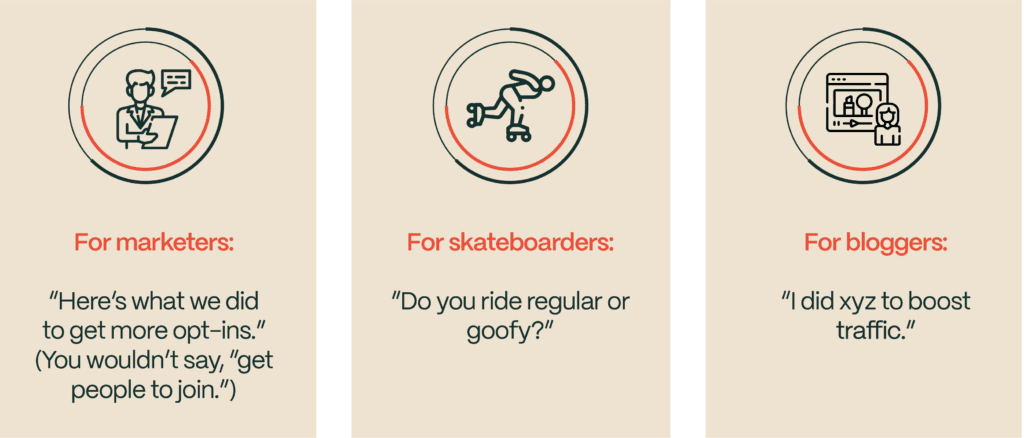
You can read the first chapter for free – just tell me where to send it:
Do this with your content and it will resonate with the people you most want to reach.
Write to One Person (Like They're Your Best Friend)
There’s nothing worse than getting junk mail from a company that rambles on and on about how great they are. You mind goes, “Blah, blah, blah” and you throw the letter in the trash.
On the other hand, when you read something that’s written to you – like a personal note – you’ll devour every word.
Why? Because you want to know what’s in it for you.
I’m the same way. As much as it hurts to admit it, people don’t care what I have to say. We’re all self-interested. And we want to read things that are specifically relevant to us.
Me, me, me.
By embracing that fact and by giving your readers all the attention and focus they want, you instantly stand out.
For example, when I used to write about personal finance, I did something that almost no other personal finance blogs were doing.
Whereas most bloggers would lecture endlessly at their readers, showing them charts about how much they could save if they just kept a budget or cut back on lattes, I wrote in a totally different way. I let myself be a real person in front of my readers.
I posted pictures of me in a toga at a party. I talked about drinking with friends. I talked about dating. And I talked about automating your money – so you don’t have to think about it.
I acted as if my readers were my best friends.
Obviously, this style didn’t resonate with everyone. But the right people were hooked – instantly. For once, they didn’t have to feel guilty about their money and what they were doing with it. Finally, someone was talking to them, not at them.
My blog has grown a lot since my personal finance days, and my audience has changed, too. But I still write to them (you) like we’ve been friends for years. I’m doing it right now!
By being personal, you’re building relationships with your readers – just like how you would if you were talking to a friend.
Keep It Simple
I’m a weirdo so I actually like reading psychology textbooks. But my god, you should see how complicated some writers make things.
- Bad writing : “In order to utilize collaborative systems more efficiently and improve mental frameworks, it is recommended that living organisms routinely tap into their psyche for daily discourse and relationship building by communicating by the written words.”
- Good writing : “Look. Send your friends a note every now and then. They need to know you care about them.”
Do you see the difference? I don’t even know what the first text means!
Simple crushes complex every day.
Now, that you know how to get your first, simple draft ready to go, you’re ready to get the piece written and polish it to perfection. Check out “Part 4: Unlocking your creativity and finding time to write” to learn how.
Part 4: Unlocking Your Creativity & Finding Time to Write
When was the last time you said to yourself, “I’d love to write, but I’m not feeling very creative right now?” That’s all well and good if you have nothing but time on your hands and your only obligation in life is to wait for the clouds to part and the brilliant ideas to flow so you can write your blog post. But my guess is if you’re reading this, you’ve not quite managed to arrange that situation yet. So, what do you do when you don’t feel like it or the creative juices aren’t flowing? You do it anyway
How You Can Be More Creative - On Demand
I’ve studied dozens of books on the writing process, interviewed bestselling authors and blockbuster screenwriters, and written a New York Times #1 bestseller.
But one of my favorite examples of someone who has mastered the art of being creative on demand is Brian Koppelman.
Almost nobody is as consistently creative as Brian Koppelman. He wrote his first screenplay, “Rounders,” while working a full-time job. He only had a few hours every day to write. So he had to produce great stuff every time he sat down. If he hadn’t, there would be no “Rounders.”
He didn’t want to be a one-hit wonder or milk the same idea for 20 years, either. He wanted to learn how to beat the odds, not through luck, but through a creative process.
Brian went on to write “Ocean’s Thirteen” and “The Illusionist.” And he’s also a novelist, director, and producer. He also started a viral Vine video series called, “The Six Second Screenwriter” and became the host of the ESPN podcast, “The Moment with Brian Koppelman”.
That’s why I invited him to my studio for an exclusive 1-on-1 session to show us his system for tapping into his creative side and what it really takes to produce great ideas.
And I’d like to share an exclusive excerpt from my session with Brian. In this video, you’ll learn more about how to be more creative and write – whenever you want.
How to Find More to Write - Despite Your Busy Schedule
I used to be amazed when I saw really busy people produce incredible blog posts day after day. I’m talking about people with full-time jobs, businesses, families, and hobbies.
I couldn’t figure out how they managed their crazy schedules and still found time to write. Were they genetic freaks? Were they lucky? Did they ever sleep? I had no idea how they did it.
That is, until I started studying top bloggers, entrepreneurs, authors, and other experts. One of my favorite bloggers/authors, Cal Newport, built an entire system I’d love to show you.
Cal Newport is the bestselling author of “So Good They Can’t Ignore You” and other bestsellers. And he’s built a cult following for his blog, Study Hacks.
But he doesn’t spend his entire day writing.
He stops work at 5pm almost every day so he can spend time reading and hanging out with his family. How does Cal “find the time” to write amazing content – and enjoy more freedom and success than most of us could ever dream of?
A while back, I brought Cal to the studio to find out his secrets. Here’s what he’s learned about carving out time and finding focus.
Not feeling creative or lacking enough time to write are two of the most common barriers people cite when they have trouble filling the page. Heck, I’ve used those excuses plenty of times myself. But just like Brian and Cal showed us, there are ways to unlock your creativity – on demand – and squeeze in plenty of time to create remarkable content.
…but you don’t have to take the same path as everyone else. How would it look if you designed a Rich Life on your own terms? Take our quiz and find out:
Part 5: Lessons From the Masters
The smartest, fastest, and easiest way to start creating amazing content is to learn from the best. What systems do they use? How did they go from being unread to running one of the top blogs in their field?
I reached out to a hand-picked selection of copywriting and marketing experts – people who reach more than a combined 125 million readers every month.
We dug deep into the important questions:
- How do you come up with such great content on a regular basis?
- What have you learned that’s had the biggest impact on how you write?
- What do most who want to hit it big not get about blogging?
- How do you know if your writing is good?
Here’s what they’ve learned from years (even decades) of studying and writing.’
I’m really excited about this section, and I guarantee it’ll be one of the biggest breakthroughs you have from this entire Ultimate Guide.
Neil Patel
Co-founder of Crazy Egg, Hello Bar, and KISSmetrics. Neil was named one of the top 10 online marketers by Forbes and writes about online marketing at QuickSprout.com.
What’s your favorite post that you’ve published recently?
“5 Steps to Creating a Profitable Facebook Advertising Campaign” is my favorite recent post. It reminded me that you don’t have to create advanced content to drive a lot of traffic. There are a lot of popular topics that still aren’t written on well.
What’s something you’ve learned recently or discovered that’s been helpful to your writing?
Something I learned recently is that most of the posts that have done well on the social web typically don’t do as well on Google.
Writing basic content that has high search volume usually isn’t as popular as click-bait from a social media perspective but, in the long run, these high search volume posts usually generate more traffic due to their search engine rankings.
What is ONE piece of advice that you’d give to someone about to start publishing content?
Use a lot of statistics and data. Posts with stats tend to generate more backlinks, which will increase your overall search engine rankings.
Mark Manson
Author, blogger, and entrepreneur. He writes about unconventional living and personal development at his blog, MarkManson.net.
What’s your favorite post that you’ve published recently?
Favorite thing I’ve written recently is “The Four Stages of Life” because a lot of the ideas came out of my own major life transitions happening this year. I also think the piece manages to be both intellectual and a bit poetic while not sounding up its own ass with self-importance. That’s a hard balance to strike.
What’s something you’ve learned recently or discovered that’s been helpful to your writing?
When to stop. I used to approach writing the same way most people approach work: do as much as you can. But what I’ve learned is that I really only have 2-4 hours of really good content in me each day. Anything past that, even if I push myself to get it out, it’s probably not going to be very good and I end up just creating revision/editing problems for myself later on. So in a way, it’s been more efficient to write less. Focus on quality over quantity. An amazing 1,000 words is worth more than a decent 3,000 words, both in terms of publishing, but also in terms of workflow and my own mental sanity.
When do you know if what you’ve written is GOOD?
When I get so sucked into it that I forget I’m the one who wrote it.
What is ONE piece of advice that you’d give to someone about to start publishing content?
Publish now. On a blog. On Facebook. On forums. Wherever. Start putting stuff up and getting feedback as soon as possible. There’s almost no downside today to putting as much of your writing out there as possible. It gets you used to exposing your work and receiving feedback/criticism. For me, you really aren’t able to get a sense of how people are viewing your work until people are actually viewing your work. So get it out there ASAP.
Brian Dean
An internationally-recognized entrepreneur and SEO expert. He is the founder of Backlinko, which provides practical strategies that professionals can use to get more search engine traffic.
What’s your favorite post that you’ve published recently, and why?
It would have to be “How to Launch an SEO Campaign In 2023.”
Creating epic content for a plumber isn’t easy. But as someone that’s ranked content in some mind-numbingly boring industries, I know it can be done.
And I love this post because it’s black-and-white PROOF that you can create remarkable content in any niche (even so-called “boring” ones). In the post I reveal how a Backlinko reader (Mike Bonadio) created a viral infographic for his client in one of the most boring industries online: pest control.
So if Mike can do it, so can you
I also love this post because it shows that remarkable content can boost your bottom line. (Because last I checked you can’t pay your employees with Facebook likes.) That means that it’s important for your content to be strategically designed for a positive ROI. And that’s exactly what happened with Mike’s infographic. Not only did Mike’s client get a surge of traffic, but the buzz boosted their organic search traffic by 15.5%.
That means that this single infographic resulted in more clients walking through the front door.
Pretty cool, right?
What’s your go-to technique/tactic when writing?
I always base my content on something that’s already proven to work. I used to fire up WordPress and stare at the blank white screen. And I’d get NOWHERE. Today, I base my content on a topic, framework or structure that’s already performed well. (I call this The Skyscraper Technique.)
For example: A while back I noticed that several other SEO blogs attempted to list out Google’s elusive list of 200 ranking factors. Even though these bloggers listed only 125 ranking factors, they got crazy amounts of links and shares. So I decided to take this proven topic and make something even better. The end result was a post on my blog called Google’s 200 Ranking Factors: The Complete List.
And to date that piece of content has generated in over 3,000 backlinks…
…and 363,000 unique visitors.
What’s something you’ve learned recently or discovered that’s been helpful to your writing, and why?
I recently learned that telling stories (ANY stories) makes your content 2x better.
When I first started blogging, I avoided personal stories and anecdotes at all costs. I thought to myself, “People subscribe to your newsletter for actionable SEO tips. They don’t care what you made for dinner.” But I kept reading about the power of storytelling. (I also noticed how much I enjoyed reading Ramit’s hilarious stories in his newsletter emails.)
So I decided to give it a shot.
I published a post that had some actionable tips like usual… But this post also outlined the story of my SEO journey.
Even though this post was 70% story, it was well received. In fact, it has over 400 comments.
What is ONE piece of advice that you’d give to someone about to start publishing content?
Don’t hit the “publish” button until you’re sure that your content is the bar-none, #1, undisputed heavyweight champion of awesomeness on that topic
John Romaniello
Angel investor, author, and expert in the fields of fitness, writing, and marketing. John is the author of the New York Times bestselling book, “Man 2.0 Engineering the Alpha,” and blogs at RomanFitnessSystems.com.
What’s your favorite post that you’ve written recently, and why?
My most recent favorite is also the most personal that I’ve ever published, titled “There’s Always More to Say: Tattoos, Semicolons, and Suicide.” The post is more or less a rundown of my personal history with depression and suicide.
It’s my favorite for a lot of reasons, not least of which is that I feel was able to truly capture the feelings of the condition and allow people in. Like all personal posts, it was scary to write and publish, but I’m of the mind that such vulnerability is one of the missing pieces for anyone who publishes personalized exposition.
In the most technical sense, while it’s certainly a clearly written piece, it’s not my most impressive piece of writing. However, where I think it really shines is in the storytelling.
Which I think should be the takeaway here: If you tell good stories, and tell them well, people will read and absorb just about anything you write.
What’s your go-to technique/tactic when writing?
In “The War of Art,” Stephen Pressfield says, “It’s not the writing part that’s hard. What’s hard is sitting down to write.”
For most content creators (and here I am especially referring to myself) I think that overcoming the inertia and just getting started is one of the most challenging parts of the entire endeavor.
The specific reasons for this are probably different for every writer, but I personally seem to struggle with blank pages. Sitting down to write and starting at a bare Word doc creates massive anxiety for me, which in turn hampers my ability to create.
To overcome this, I’ve got a few strategies.
- Firstly, I notice that the more “formal” the writing seems, the harder it is to get going. While opening getting started in a word document is difficult, writing in an email comes more easily. For that matter, typing it in an app like Notes, or even in the body of a text message allows things to flow pretty easily. So I’ll often write up to half of an article somewhere else, and then copy and paste it over to a Word doc. Further, I find that things flow more easily when I write by hand than type them, so I often get started in a notebook.
- Secondly I create a simple outline. I more or less write my three main ideas, and then leave space for 1-3 supporting points for each of those ideas. From there, I write one sentence for each idea, and one for each supporting point. Many times, just creating this skeleton is enough to grease the wheels and let things flow.
- Thirdly, I impose time limits for specific projects. When it comes to my writing, I can fall into the trap of perfectionism, and agonize over every word. Probably necessary if you’re writing the great American novel, but when you’re writing about nutrition, this is a waste of time. Once I’ve got an outline done, I like to force myself to finish a draft as quickly as possible.
When do you know if what you’ve written is GOOD?
Hemingway said, “All you have to do is write one true sentence. Write the truest sentence you know.” No matter what I’m writing about, I try to follow this maxim.
As long as a piece communicates the information clearly and effectively, and there’s at least one sentence that I feel truly proud of as a writer, I’m confident shipping it.
What is ONE piece of advice that you’d give to someone about to start publishing content?
Read everything you write out loud. In fact, have someone else read it out loud. If there are sentences that cause them to stumble or if the article does not flow well, be willing to go back and edit—a lot. If it sounds like shit, it reads like shit.
Steve Kamb
Author and the creator of NerdFitness.com, a website to give average people struggling to get healthy a fighting chance.
What’s ONE surefire way to overcome writer’s block?
I’m always reminded of a quote: “I only write when inspiration strikes. Fortunately it strikes at nine every morning.”
The best possible cure I’ve found to overcome writer’s block is to set myself up to succeed: a clean desk, a cup of coffee, distracting websites blocked (I use the program “Freedom”), and a great playlist (usually vocal trance).
I then task myself with writing 500 words of whatever. It can be terrible, it can be grammatically incorrect, but I need to write 500 words. Usually after 20 minutes, an idea is sparked, something new is discovered, something written gets me in the zone, and I can kind of zone out and just crush content.
When do you know if what you’ve written is good?
This is a tough one, as it’s pretty subjective. However, it’s often the things that I have the most fun writing, the articles that I truly enjoy putting together, that tend to resonate the best with my audience. I love breaking down a difficult concept or a controversial topic and attacking it from a unique angle with our twist of nerd culture references and lessons. Occasionally I’m off in my predictions, but when I’m writing something and saying, “I can’t freaking wait to publish this,” those are the articles that go over incredibly well.
What is ONE piece of advice that you’d give to someone about to start publishing content?
Please be freaking unique, especially if you’re jumping into a crowded industry. Nerd Fitness has been successful because I write in a way that you can’t find anywhere on the internet: diet and fitness advice, catered specifically to beginner nerds, wrapped in nerdy metaphors and video game analogies. Don’t try to appeal to everybody – start by catering to a tiny subset of people that you can speak with directly, and only after you’ve made a name for yourself in that arena can you start to expand your target audience.
Part 6: Getting Your Remarkable Content in Front of Others
Now that you know how to get great ideas, beat writer’s block, polish your post, and steal from the masters, you have to make sure your writing gets in front of the people who matter most – your ideal target market. And trust me, they’re not going to hunt you down. You have to go to them.
The best way to get your work in front of millions of people is by guest posting on blogs that are bigger than yours.
Instead of spending years slowly gaining one reader at a time, tap into blogs that already have an engaged audience – audiences that are 2x, 5x, 100x bigger than yours. When you get your work in front of that many new readers, everything changes.
For instance, you met one of my graduates, Selena Soo, earlier. She had one guest post that changed the game for her. I asked her to share just some of the ways her business and life improved after a guest post on my site.
Here’s what just ONE guest post did for Selena, in her words:
“When I was invited to write a guest post for IWT, I knew it was going to be one of the biggest exposure opportunities for my business. After all, Ramit has 215,000 highly engaged and responsive newsletter readers.”
Here’s a summary of what happened:
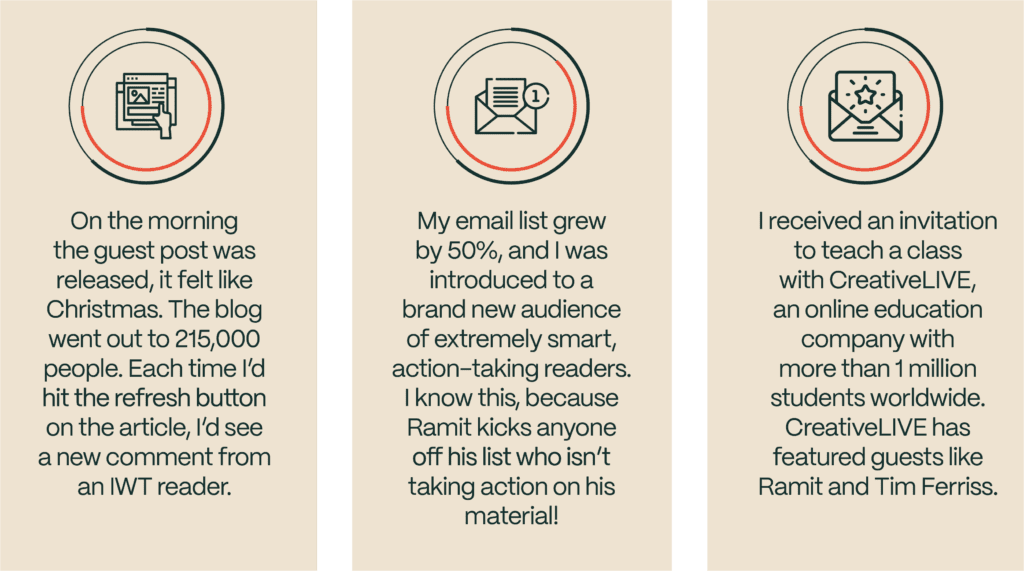
All that, and she was just getting started. You can see how she turned this exposure into $30,000+ in the field report at the end of this section.
But for now, let’s dig into what she did to land a guest post in the first place. You can copy the exact methods she used, even if you don’t have connections or a big following.
Find Out Who You Should Be Writing For
Most people start with an idea and immediately jump right into writing a post. In contrast, the very best bloggers and entrepreneurs are more methodical and deliberate.
Here are the most important questions you should ask yourself before a single word hits the page:
- Who am I trying to reach?
- What potential audiences would be interested in my work?
- Where are they? (What blogs do they read?)
- What urgent problems are they facing?
- How can I help them solve their problems?
When you start by finding the right potential audience – and understanding their burning pains – your message will spread even faster. Be very specific. Think beyond just the demographics, and dig into their mindset.
For instance, for social skills, you might want to target job hunters who want to nail their next interview, employees who want to move “up the ladder,” or people who just moved into a new city and want new friends. Once you’ve answered these initial questions, you can start brainstorming ideas and begin your outreach.
How To Get Your Blog Post on Your Favorite Sites (Including Exact Scripts)
Imagine that you get 1,000 emails every day. You’re busy. And have a lot on your plate. Then, out of the blue, somebody sends you a long, rambling email about how they want to write a guest post on your site. The email doesn’t explain how they can help you, and it’s not clear what you should do next.
Are you going to spend hours going back and forth with this random person? Or are you just going to hit delete?
Delete.
That’s exactly what it’s like for people that run big blogs with big audiences. They get crazy requests like this all the time.
And if you send an email like that, you have zero chance of getting published on their site.
Here’s how you can be different.
Use my favorite strategy for getting any VIP’s attention. This technique makes it almost impossible for them to turn you down. Here’s an overview of what your email pitch should include:
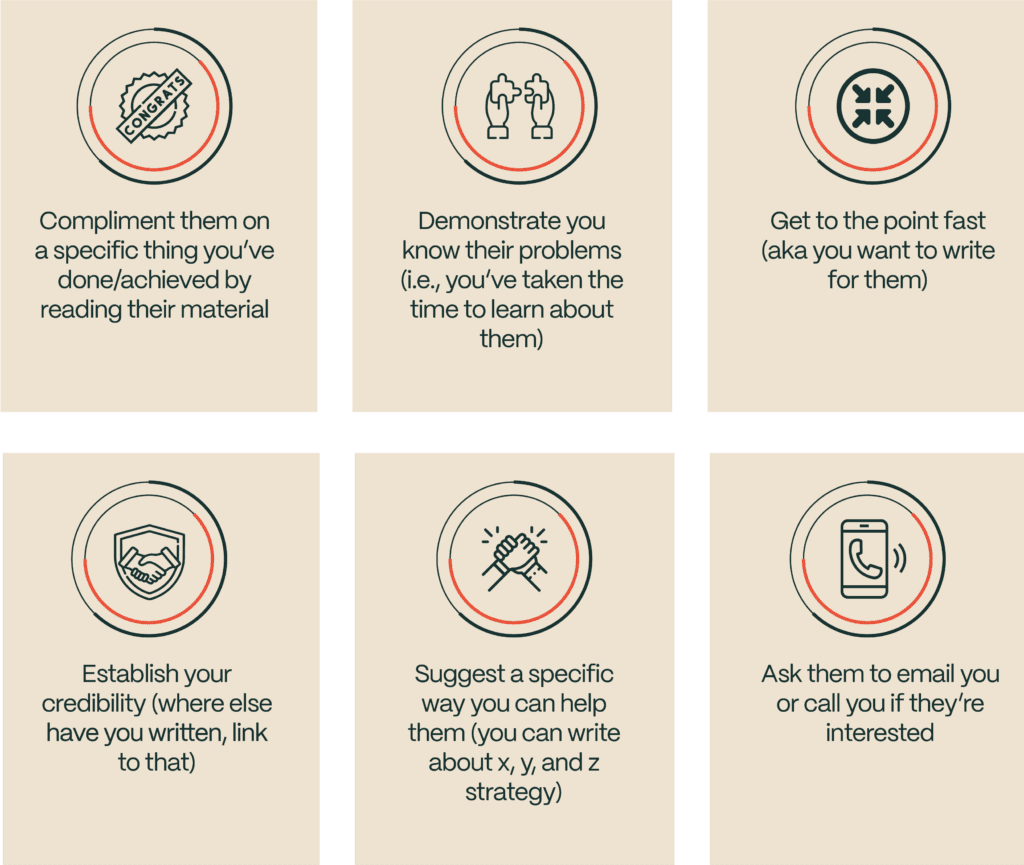
And here’s an exact email script you can use to reach out:
Hey [NAME],
Ever since I tried your ABC strategy, I’ve been getting amazing results. In fact, I already [INSERT SPECIFIC RESULTS YOU GOT FROM THEIR TECHNIQUE].
I seriously appreciate all the hard work you do to create useful, actionable advice about [SUBJECT].
I know you’ve got a lot on your plate. And writing the top-notch content you always produce takes a lot of time – so I was wondering if you’d like a hand with it. [THIS IS SHOWING YOU UNDERSTAND THEIR PAIN]
I’ve already brainstormed a few ideas that I think your readers would love: –
[INSERT IDEA 1] – [INSERT IDEA 2] – [INSERT IDEA 3]
I’ve written a lot on this [SUBJECT]. Here are a few examples of my work. You can see that other readers really enjoyed the level of detail I go into on each post.
– [LINK TO GUEST POST #1] – [LINK TO GUEST POST #2]
You don’t publish guest posts very often, but I’d love to be able to write for [THE SITE NAME].
If you’re not interested, no sweat. I’ll still be an avid reader and fan.
Thanks,
[YOUR NAME]
Selena used this strategy, along with my word-for-word email scripts, to land a huge guest posting opportunity. And I want to share her field report with you. You’ll see how it changed her business and her life.
Part 7: What's Next
You’ve learned some of the key systems and strategies you need to create unforgettable content.
And you’ve seen how to do it in days or weeks, instead of the years and years it took me. Now, I want you to have even more of my best material on how you can turn your writing skills into an even richer life.
If you want more help, join my Call to Action program. Call to Action helps you create amazing copy that resonates with your customers, friends, co-workers, and more.
In our business, copywriting was one of our Big Wins — once we improved our copywriting, our business grew exponentially.
We want to show you how to use the same copywriting principles in your business and personal life.
Join Call to Action and learn about more programs here.
If you liked this guide, you’ll LOVE my Insider’s Newsletter
Join over 800,000 readers getting content that’s not available on the blog, free:



